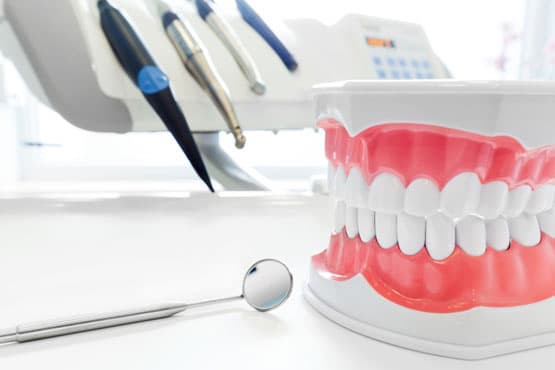Traditional Dentures are prosthetic devices that basically serve as false teeth. They can take the place of some (partial) or all (complete) teeth. Dentures support facial muscles, tissues of the mouth and functions like chewing and talking. People become edentulous for many reasons, when this occurs dentures should be considered as a viable replacement.
Traditional Dentures: Partial
For a person missing several teeth, a partial denture can be used to restore oral health. Partial dentures are available in two forms, removable or fixed (permanent). The prosthesis is made from a metal framework that holds the plastic teeth and gums in place. Each option presents its own benefits, depending on the needs of the patient.
Removable partial dentures can be removed and reinserted without the help of a dental professional. They attach to the remaining natural teeth with a metal clasp or precision locator attachment. This ability to be removed allows for easy maintenance and cleaning.
Another benefit of removable partial dentures is the minimal tooth preparation that they require. The tooth structure must be slightly removed to accommodate the device.
A fixed partial denture is a permanently attached prosthetic device, supported by implants or prepared natural teeth, that replaces one or more missing teeth. The fixed partial denture is better known as a bridge, and is recognized as an advanced dental solution.
Traditional Dentures: Complete
Traditional Dentures have been a preferred choice for edentulous dental patients for many decades. They can help a patient who has lost all of their teeth to regain a cosmetic smile and functionality associated with eating and speaking. Traditional dentures offer an affordable alternative to other teeth replacement options.
These complete traditional dentures can be quite uncomfortable if they are not properly fitted to maximize retention and stability. In order to ensure a proper fit, it is important to make use of the total available surface area of the mouth. Typically the full upper denture will cover the entire palate of the upper mouth, creating a large surface area for attachment. The suction between the denture and the soft tissues of the mouth create an air tight seal allowing for secure adhesion.
Limitations of Dentures
Full lower traditional dentures can present some adhesion and stability issues. The lower jaw anatomy does not allow for as much surface adhesion. Combined with this is the fact that the lower jaw is also much more active. The lower jaw is the prime mover in speaking, eating and swallowing. For these reasons, good adhesion is much more difficult to achieve when dealing with complete lower dentures.
The inability to prevent bone re-absorption is another pitfall of complete traditional dentures. The presence of teeth is a major factor in preserving the jaw ridge, and maintaining its bone density. Without the structural support of the teeth, bone is reabsorbed, resulting in loss of the jaw ridge and softening of gum tissues. This can lead to more instability of the traditional denture, as well as increased discomfort.
This loss of structure will cause traditional dentures to recede, changing the fit and bite of the prosthesis. Each patient is different, but it is recommended that dentures be relined every 2 years, with replacement necessary after 5 to 6 years.

